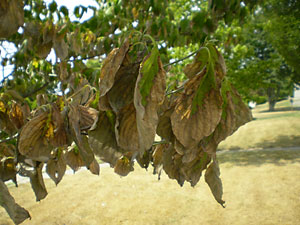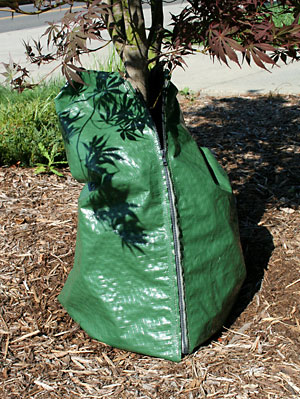
The combination of record-setting temperatures, an intense heat wave in early July, and rainfall less than half of normal in some areas scorched many Northeast landscapes this summer. So, according to Cornell scientists, what’s your best bet to save your grass, trees and shrubs?
Water your trees and shrubs, but not the lawn.
“Overwatering during hot weather does far more damage to a lawn than drought,” says Frank Rossi, turf specialist in the Department of Horticulture at Cornell University. Watering – particularly frequent light watering – encourages lawn diseases and weeds, he explains.
The cool-season lawn grasses commonly grown in the region naturally slow down as temperatures rise and soil moisture decreases, even in normal summers, notes Rossi. In hot dry years like this, he suggests just letting the lawn go completely dormant.
“Think of your lawn like a hibernating bear,” he suggests. “Many lawns will turn completely brown. But most of the lawn grasses will survive 4 to 6 weeks without significant rainfall.” In most cases, they’ll green up again in late summer or early fall when the rain returns and the temperatures moderate.
But that’s not the case with trees and shrubs, says Nina Bassuk, director of the Urban Horticulture Institute in Cornell’s Department of Horticulture. “When it’s really hot and dry, many trees and shrubs will shed their leaves – and some will just dry up. Drought is very stressful and can sometimes kill them outright,” she points out.
Newly planted trees and shrubs are particularly vulnerable because their root systems aren’t fully developed. They have a harder time foraging for moisture, warns Bassuk. Depending on the species, site and planting practices, that might mean keeping two- to five-year-old plantings carefully watered during dry periods, hopefully preventing drought-caused leaf damage or loss in the first place.
But don’t give up on trees and shrubs that have shed their leaves, says Bassuk. “Go ahead and water them,” she suggests. “It’s better late than never. If they’re still alive, they’ll grow new leaves. And after two weeks of photosynthesizing they’ll have made up for the extra effort it took them to re-leaf.” Any extra energy the leaves gather after that can be channeled into new growth or stored by the plants to help them get through winter.
Water slow, water deep

The key to watering trees and shrubs is to water them slowly and allow the water to soak deep into the soil with no runoff. “You can’t really do that standing there with a hose in your hand,” observes Bassuk.
One solution is to use plastic drip irrigation bags that encircle the trunk of the tree. They can be quickly filled with a hose and then they slowly release the water (typically 20 gallons) over 8 to 12 hours. “You need to refill them if you want them to work – usually weekly but up to every three days when it’s really hot and dry,” says Bassuk. Special soaker hoses can also deliver water at a slow rate.
If you only have a few trees and shrubs to water, you can just use a hose turned on to a slow trickle – but you need to monitor them and move them before the water starts running off. Another low-tech solution is to drill small holes in the bottom of plastic buckets or trash cans, place them around the trees and shrubs, and fill them with water. “It’s not pretty, but it works,” says Bassuk.
Part of Bassuk’s research program involves studying how well different tree species recover from heat- and drought-stress. “If we’re smarter about what trees we plant in our urban areas, we’ll lose fewer next time we have a summer like this.”
Watering tips for trees and shrubs:
Watering tips for lawns:
More information: |


